|
While Shuri Castle brings back the heyday of the Ryukyu Kingdom with colorful buildings and gorgeous artifacts, there are some neighboring areas that show scenes from the past in a subtle way.
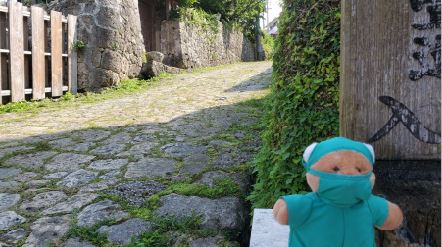
|
Doctor Bung accompanied me this day as we explored the Kinjo michi. Though only a short walk the day was warm and the walk back was mostly uphill. Kinjo-cho Ishidatami Michi (stone-paved road) runs on a downslope on the southwest side of the castle. Although stone-paved are common in Okinawa, this one gets a lot of media coverage due to its vantage point and stunning views.
|
|
The north end of the road is a 10-minute walk from Shuri Castle. It starts with a straight stretch that goes through a tunnel of trees before winding downslope with moderate curves. According to Naha City Tourism data, the road is about 300 meters long, with an average width of four meters. |
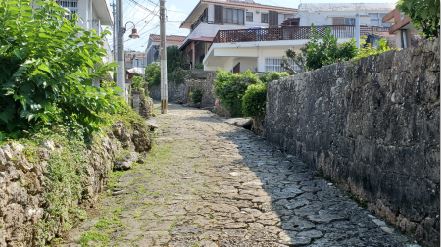
|

|
The road paved with Ryukyu Sekkaigan (limestones) draws a beautiful geometry with small green plants popping between the stones, creating a clear contrast with the dark color of the stones. When the stones are wet, the contrast becomes even clearer. I was initially shocked when I saw a car in a driveway along this road. I had not considered that it was actually a usable road and that residents use it daily.
|
|
Here and there, the road branches into smaller streets, which lead to curious spots. One of them is a large tree called “Akagi” or Bischofia javanica. A description posted nearby notes that the tree is about 20 meters high and believed to be 200 years old. Another description notes that around 340 years ago, locals felt a remarkable aura in a forest in the area. They asked the government of Ryukyu Kingdom to install a place of worship where people can interact with gods. The tree remains at the sacred site.
|
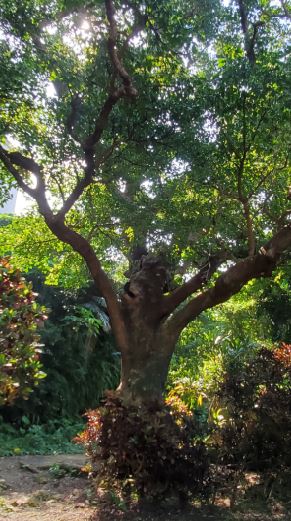
|
| |
|
There are also water channels and wells along some of the streets, which are thought to be historical sites as well. Walking on the small winding streets between local residences often feels like going in a labyrinth. At locations where such streets connect to each other, there are Ishigantou stone slabs, which are thought to fend off evil spirits.
|
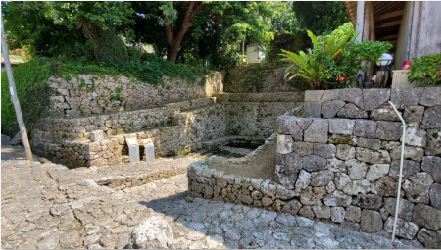
|
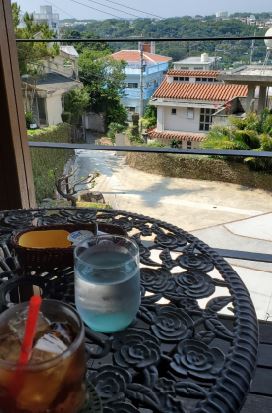
|
When they get a little tired after going on the steep slope or intricate streets, visitors can take a break at a rest area with public restrooms made to look like a traditional Okinawa-style house. There are also restaurants and cafes for a quick bite along the way. I wasn't as much interested in a "bite" but was very, very interested in something to drink. The guy who operates this cafe knows full-well that he has a choice location and a sort of "captive audience" as he charges - and gets - JY500 for a simple glass of tea! It was hot and I was pooped and I paid. Lots of tea and ice water put me back on my feet.
Compared to Shuri Castle, the stone-paved road may not draw as many tourists, but the secluded location has historical significance that may be of interest to history buffs.
|
|
According to the Naha City Tourism database, the construction of the road began in 1522 as part of Madama Michi, a road which used to run from Shuri Castle to then-Naha port. Shuri Castle’s website notes that the port was in Sumiyoshi-cho, which is now a part of Naha Military Port. Against the backdrop of increasing threats of pirates, the road was intended to be used to mobilize military forces to defend the port.
|

|
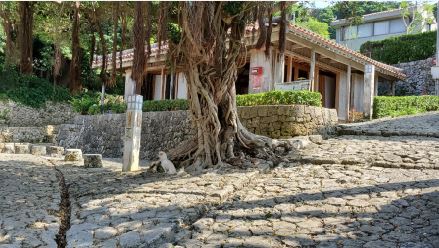
|
The stone-paved road near the castle has survived many trials, still providing picturesque vistas of old Ryukyu and a glimpse into the kingdom’s strategic infrastructure for defense. I was late getting to it despite being high up on my 2019 list of places to go. So many unplanned things kept pushing it back. Time was getting short so my good buddy, Dr. Bung, kicked me in the butt that May 13th morning and reminded me that he'd been waiting long enough! Mission accomplished.
|
|

